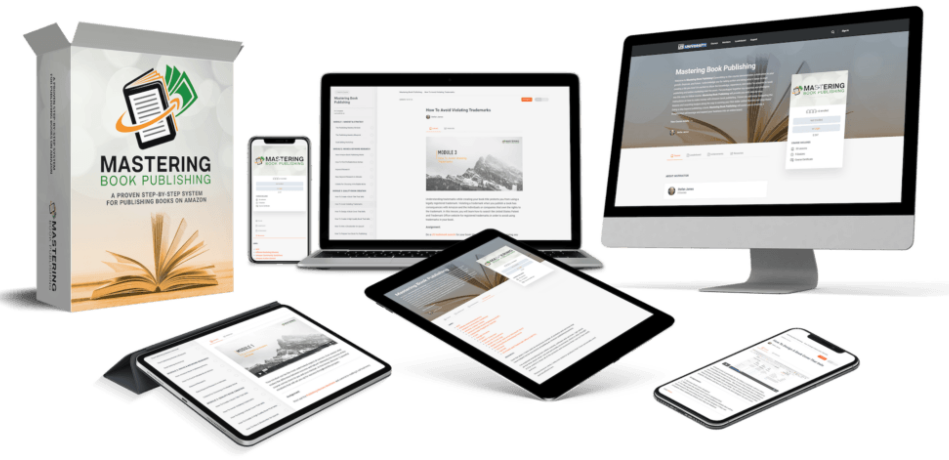
In this article, we give you a Mastering Book Publishing Review that will enable you to make an informed choice before you buy. When you set out to publish a book, understanding the whole process upfront is key. This journey can feel overwhelming at first, but with a clear path, the stress melts away. The primary aim is to bring your story or ideas to readers in the most engaging way possible.
Mastering book publishing isn’t just for authors with years of experience. Even if you’re a newcomer, there’s a lot to gain from knowing the ins and outs of publishing. This helps in making informed decisions along the way, ensuring that your book reaches its highest potential.
This article is crafted for those ready to explore and conquer the world of book publishing. Whether you’re an aspiring writer with a manuscript in hand or someone just curious about the publishing world, the following sections will provide a comprehensive guide.
Contents
Understanding the Book Publishing Process
The book publishing process can be a bit of a maze, but breaking it down into clear steps makes it manageable. Whether you’re opting for traditional publishing or self-publishing, knowing what to expect can save you from a lot of headaches.
In traditional publishing, submitting a manuscript to a literary agent is often the first major step. If the agent signs you, they’ll pitch your book to various publishers. If a publisher is interested, they’ll offer you a contract, which generally includes an advance against royalties. Then comes editing, designing covers, and finally, marketing your book.
Self-publishing, on the other hand, gives you complete control but also means you’ll be handling everything yourself or hiring freelancers. From writing and editing to design, formatting, and marketing, each step is crucial. The perks? You keep more of the profits and have full creative control. The downside? It can be a lot more work and more initial cost upfront.
It’s crucial to weigh the pros and cons of each approach. Traditional publishing can offer a sense of prestige and broader distribution, but it also means ceding some control and potentially facing long waiting periods. Self-publishing is quicker and gives you more freedom, but it demands more from you in terms of time, effort, and often money.
No matter which path you choose, understanding these steps and preparing accordingly can make the entire journey smoother. Knowing what lies ahead will help you make wiser choices, setting your book up for success from day one.
Finding Your Niche Market
Choosing the right niche can make or break your book’s success. When you pinpoint a specific market, you not only target readers who are interested but also reduce competition. A well-chosen niche can set the stage for your book to stand out.
The first step is research. Look at current trends, popular topics, and gaps in the market. Online platforms, bookstores, and forums can offer valuable insights into what readers are looking for. Tools like Google Trends can help you see what subjects are currently popular.
Examining bestsellers in your chosen area can provide a clear picture of what works. Notice the genres, themes, and even the cover designs. Successful books often share common traits that you can adapt and make your own.
Talk to potential readers. Engage with communities or individuals who fit your target audience. Getting feedback on your ideas can offer fresh perspectives and confirm if your chosen niche has a hungry audience waiting.
Remember, a niche that’s too narrow may struggle to find a large enough audience, while one that’s too broad might get lost in a sea of competitors. Balance is the key. Find a niche that’s specific, marketable, and something you’re passionate about.
Crafting a Compelling Manuscript
Creating an engaging manuscript requires more than just good ideas. It’s about presenting those ideas in a way that keeps readers hooked from start to finish. Start with a clear structure and outline to guide your writing. This helps organize your thoughts and ensures your narrative flows smoothly.
Short sentences enhance readability. They make complex ideas more digestible and keep the reader’s attention. Use transition words to link your thoughts. Words like ‘and’, ‘but’, ‘so’, and ‘because’ create a natural progression for your arguments and stories.
Subheadings break up your text, making it more approachable. They act as signposts, guiding readers through your content. Each subheading should give a hint about the following section, sparking curiosity and keeping the reader engaged.
Editing and proofreading are non-negotiable. No matter how great your ideas are, typos and grammatical errors can undermine your credibility. Consider hiring a professional editor if your budget allows. Fresh eyes can catch mistakes you might have missed. Online tools like Grammarly can also help polish your manuscript.
Writing isn’t just about putting words on a page. It’s about connecting with your audience and providing them value. Always write with your reader in mind. Ask yourself if what you’re writing aligns with their interests and needs. This helps create a manuscript that resonates and stays with them long after they’ve turned the last page.
The Role of Design and Formatting
Design and formatting are essential elements that can influence a reader’s first impression and overall experience with your book. A well-designed cover can grab attention and make your book stand out on crowded shelves or online catalogues. It’s often worth investing in a professional cover designer who understands market trends and can create an eye-catching design that represents your book’s content effectively.
Formatting the interior of your book is equally important. Clean and consistent formatting makes your book easier to read and gives it a polished look. Pay attention to details like font size, line spacing, margins, and chapter headings. Tools like Adobe InDesign or Vellum can assist in creating professional-quality interiors. If you’re not comfortable doing it yourself, hiring a professional can ensure your book looks great on both print and digital platforms.
Another critical aspect is the layout. Proper layout enhances readability. Avoid dense blocks of text by using paragraphs and spacing wisely. This keeps readers engaged and makes your book more approachable. Decorative elements like drop caps at the beginning of chapters or section dividers can add a touch of elegance, but use them sparingly to avoid cluttering the page.
Think about the reader’s experience. A cluttered or poorly designed book can be frustrating to read and may turn readers away. On the other hand, a well-designed book invites readers in and enhances their experience, making them more likely to recommend it to others.
Lastly, always proofread your design. Print a few test copies and review them thoroughly. Digital proofreading is good, but seeing the physical copy can reveal issues you might miss on a screen. This final check can make a significant difference in your book’s professional appearance.

Marketing and Promoting Your Book
Marketing and promoting your book effectively can make a substantial difference in its reach and success. A great book won’t sell itself; a well-thought-out marketing strategy is essential.
Begin with a solid plan. Identify your target audience and where they spend their time. Are they on social media? Do they frequent certain websites? Knowing this helps focus your efforts where they’ll have the most impact.
Leverage social media platforms to build your author brand and engage with readers. Regular posts, interacting with followers, and sharing updates about your book can create buzz. Join online communities and forums related to your book’s genre or subject matter to connect with potential readers.
Book reviews and testimonials can significantly boost your book’s credibility. Reach out to book bloggers, reviewers, and influencers who align with your niche. A positive review or a shout-out can introduce your book to a broader audience.
Hosting virtual events, such as live readings or Q&A sessions, can create excitement. Use these opportunities to interact with readers, answer their questions, and share behind-the-scenes insights about your writing process.
Don’t underestimate the power of email marketing. An email list is a direct channel to interested readers. Offer free chapters or other exclusive content to encourage sign-ups. Regular newsletters keep your audience informed and engaged.
Consider investing in paid advertising. Services like Amazon Ads, Facebook Ads, or even Google Ads can extend your reach beyond organic efforts. Monitor the performance of these campaigns and adjust them as needed to maximise their effectiveness.
Marketing your book effectively requires time and effort, but the results can be rewarding. A smart and targeted approach ensures that your hard work in writing and publishing the book pays off in real-world success.
Evaluating Your Success and Adjusting Course
Tracking your book’s performance is an ongoing process. It’s not just about initial sales figures; it’s about understanding what drives those sales and how to sustain and grow them. Use sales data and reader feedback to get a comprehensive view.
Sales platforms like Amazon, Barnes & Noble, and others often provide detailed analytics. These metrics tell you where your sales are coming from, which marketing efforts are working, and which aren’t. Tools like Google Analytics can track traffic to your author website and help identify which strategies bring the most visitors.
Reader reviews and feedback are invaluable. Pay attention to what your readers are saying about your book. Their comments can reveal what resonated with them and what might need improvement. Engage with your readers to show you value their input, and use this feedback to refine your future work.
Be ready to adapt your marketing strategies based on this information. If a particular social media campaign or advertising effort proves effective, consider doubling down on it. If something isn’t working, don’t be afraid to pivot and try new approaches. Flexibility can lead to discovering unexpected opportunities.
Consider your book a living project. As new feedback comes in and market conditions change, continue to tweak and improve your strategy. Stay informed about trends in publishing and marketing to keep your efforts relevant and effective.
Future steps might include expanding your book into different formats, like audiobooks, or exploring foreign language translations. Continuous improvement keeps your book relevant and can open up new revenue streams.
Remember, success in book publishing is often a marathon, not a sprint. Stay committed to learning and adapting; your efforts will pay off over time.






